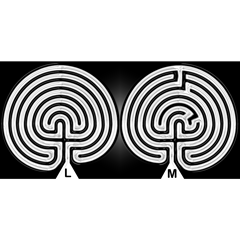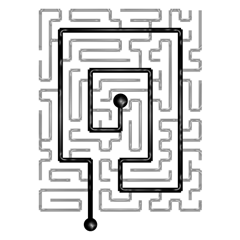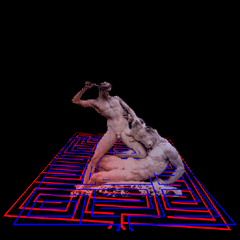
The best myths prevail because they sparkle with archetypal energy, holding timeless truths which speak to both listener and tale-teller. Similarly, the magical tools that survive are the ones that are flexible, and user-friendly; and demonstrate to an apprentice very quickly that they do actually work. And if that makes it sound like myth and magic are things outside of ourselves, with an intelligence and existence of their own, then - good! Now we can begin exploring the concept and visual pattern of the labyrinth, and its fragmented user guide, the Minotaur myth.
Cropping the myth down from its many authors’ contradictory accounts into a single sentence, is really hard to do: but here is the ADHD version of the Minotaur myth.

Every few years a set of youths and maidens from Greece were demanded by Crete, and were put inside a huge maze-prison built by brilliant inventor Daedalus, in which lived the son of the King and Queen of Crete, Minos and Pasiphae, a half-animal half-human creature called the Minotaur.
Theseus, son of the king of Greece, snuck over as one of the youths. Ariadne fell in love with him, learned from Daedalus how to navigate the maze, gave Theseus a ball of thread which she held one end of, and entered the maze, killed the Minotaur, found his way out along the threat again, and escaped with Ariadne and the other Greeks.
Now, in modern labyrinthology, authors distinguish carefully between ‘labyrinth’ and ‘maze’:

A labyrinth (left) has one route from start to finish. A maze (right) has one route from start to finish, but offers path-choices, dead ends and/or loops.
The specific labyrinth pattern above is the most common one, historically; evolving round the Mediterranean and Baltic Seas, spreading along the Silk Route into Asia; appearing (probably independently) in North America; and, meanwhile, developing in medieval European manuscripts into the form of which Chartres Cathedral labyrinth is most famous.
Now, that long European tradition of labyrinth-drawing wouldn’t have happened if the myth of Ariadne, Theseus and the Minotaur hadn’t kept alive the whole labyrinth idea (from late Antiquity to Medieval times, as taste for Ovid’s tales which described the legend, remained great). First the labyrinth spread through the Roman Empire with mosaics illustrating the myth; then, over centuries of (largely Christian) manuscript-copying, Theseus, Ariadne and the Minotaur slowly were replaced in and around the labyrinth by Christ, Mary and Satan: different faces, same motif.
But here is where it gets complicated a moment - for over all these centuries, we’re see only pictures of labyrinths illustrating what is clearly, in Ovid, Pliny and the later commentators, a maze.
Even if we boil down the story into a single concept (inside a confusing maze you can’t get out of, is a suprahuman creature waiting to kill you, which you must outwit) we need a maze, not a labyrinth. A labyrinth, in fact, promises certain death; at least in a maze you have a chance (choice) of surprising an enemy. Yet, bizarrely, in art (graffiti, coins, mosaic, paintings, pottery) the Minotaur’s lair is always depicted as a labyrinth - never once a maze. Why is this?
Well, you could fill libraries with the books written on this topic. (A mobile library, anyway.) The answer I use in my workshops, however, is a nice simple one. First let’s rephrase our questions as, ‘Why was the maze (the visual shorthand version) of this myth, traditionally illustrated as a labyrinth?’ In other words, what is the narrative point of the story overall?
It is that Theseus with Ariadne’s aid solved the maze. And take away the dead ends followed, the loops, the mistakes made in walking any maze, and you are left with a one-route path from start to finish, a unicursal labyrinth. Just as was traditionally illustrated until the 16th Century, when the first mazes appeared, on paper and in gardens as the labyrinth became a secular ornament.

Of course that labyrinth won’t be so neat as the one in the picture here. But a less-common definition of the labyrinth, is that of being the ‘correct path’ chosen created by wilfully learning from doubt-filled dead ends, and fear-driven behavioural loops. We do a lot of this in my workshops - create and work with ‘life labyrinths’ representing our ‘best shot’, an all-positive take on an life. The labyrinth ideal that Theseus walked to survive, was less of a physical construct, as a symbolic route to victory and success. Today, the labyrinth’s appeal is the same around the world; it is walked for powerful visualisation, deep prayer, loving healing meditations, and releasing the child within. Less aggressive terminology, but the same outcome: to survive life, better.
I think this also explains why labyrinths historically have been embraced and developed as a motif under Christianity, Judaism, Hinduism, Scandinavian Paganism, and Arizonan Native American religious traditions, to name the easiest-to-pigeonhole. Labyrinths are highly flexible tool, and easy to discover when playing with a stick and a spiral. Naturally people will use it to illustrate a path of transformation life and death, human and animal form, the seasons, good and evil, birth and the womb...
The transformation theme, itself, screams at us on all sides from the Minotaur myth, even when we try to balance out the many, many ancient authors that Plutarch tried to summarise (himself writing a thousand years after the ‘events’ - if any - happened). The characters who walk the maze, are transformed: Theseus (victim to conqueror), Minotaur (live, poor guy, to dead), and Daedalus (earth-bound, to skyborne; he is locked in the maze by angry Minos after Theseus and Ariadne depart, and escapes by making wings and flying away).

